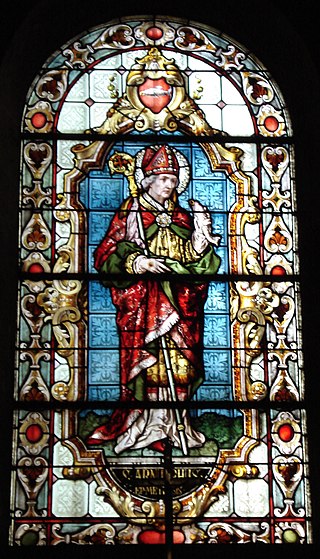Related Research Articles

Balthild, also spelled Bathilda, Bauthieult or Baudour, was queen consort of Neustria and Burgundy by marriage to Clovis II, the King of Neustria and Burgundy (639–658), and regent during the minority of her son, Chlothar III. Her hagiography was intended to further her successful candidature for sainthood.

Arnulf of Metz was a Frankish bishop of Metz and advisor to the Merovingian court of Austrasia. He later retired to the Abbey of Remiremont. In French he is also known as Arnoul or Arnoulf. In English he is known as Arnold.

Sigismund was King of the Burgundians from 516 until his death. He was the son of king Gundobad and Caretene. He succeeded his father in 516. Sigismund and his brother Godomar were defeated in battle by Clovis's sons, and Godomar fled. Sigismund was captured by Chlodomer, King of Orléans, where he was kept as a prisoner. Later he, his wife and his children were executed. Godomar then rallied the Burgundian army and won back his kingdom.

Galswintha (540–568) was a queen consort of Neustria. She was the daughter of Athanagild, Visigothic king of Hispania, and Goiswintha. Galswintha was the sister of Brunhilda, Queen of Austrasia; and the wife of Chilperic I, the Merovingian king of Neustria. Galswintha was likely murdered at the urging of Chilperic's former concubine Fredegund, instigating a 40-year civil war within the Merovingian kingdom.
Fredegund or Fredegunda was the queen consort of Chilperic I, the Merovingian Frankish king of Soissons. Fredegund served as regent during the minority of her son Chlothar II from 584 until 597.

Aregund, Aregunda, Arnegund, Aregonda, or Arnegonda was a Frankish queen. She is the earliest known queen of Francia.

Burgundofara, also Saint Fara or Fare, was the founder and first abbess of the Abbey of Faremoutiers.

Audovera was the first wife or mistress of Chilperic I, king of Neustria.

Chelles Abbey was a Frankish monastery founded around 657/660 during the early medieval period. It was intended initially as a monastery for women; then its reputation for great learning grew, and when men wanted to follow the monastic life, a parallel male community was established, creating a double monastery.
Eustadiola (594–684) was a saint, widow, and abbess. She was born to wealthy and politically powerful parents in Bourges, France. She married due to pressure from her family, but became a widow at a young age, which gave her the financial and social independence to live what Sainted Women of the Dark Ages centuries later called a "semiretired religious life". She gave away her wealth to the poor, founded churches, monasteries, and convents, and used her wealth and influence to expand and decorate the buildings. Eustadiola was abbess of the convent she founded in Bourges, and lived as an ascetic for 70 years. Many miracles and healings were attributed to her. Her feast day is celebrated on 8 June.
Ostrogotho was the daughter of the Ostrogothic king Theodoric the Great, and the wife of the Burgundian king Sigismund.
The Vita Sadalbergae is an anonymous Latin biography of Saint Sadalberga, founder of the Abbey of St John, Laon. Its author claims to be writing at the behest of Sadalberga's daughter and successor as abbess, Anstrude, but the date and reliability of the Vita are disputed by scholars.

Agilberta, also known as Aguilberta of Jouarre and Gilberta of Jouarre, is a Benedictine French saint, venerated in both the Roman Catholic Church and Antiochian Orthodox Church. She was a nun and the second abbess of the Jouarre Abbey, in the département of Seine-et-Marne. Agilberta was a relative of Ebrigisil and Ado, who founded Jouarre in 660. Her brother, Agilbert, was bishop of Paris. Agilberta's sister, Balda, was Jouarre's third abbess.

Balda of Jouarre was the third abbess at Jouarre Abbey in north-central France. She was a nun at Jourarre for many years, under her nieces Theodichildis and Agilberta, who were abbesses before her. Her nephew, Agilbert, was bishop of Paris. She might have been related to Sadalberga.
Slavery in France, and by extension, the French Empire, covers a wide range of disparate topics. Some of the most notable ones include:

The harem of the caliphs of the Abbasid Caliphate (750–1258) in Baghdad was composed of his mother, wives, slave concubines, female relatives and slave servants, occupying a secluded portion of the Abbasid household. This institution played an important social function within the Abbasid court and was that part were the women were confined and secluded. The senior woman in rank in the harem was the mother of the Caliph. The Abbasid harem acted as a role model for the harems of other Islamic dynasties, as it was during the Abbasid Caliphate that the harem system was fully enforced in the Muslim world.
Austregilde, also called Austerchild,Austregildis,Bobilla,Bobile, and Austrechild in most contemporary works and scholarship, was a Frankish queen consort of the Burgundy region in the 6th century. As a woman of the Merovingian elite, Austregilde held a fairly large amount of power, yet this power was limited by Salic law and societal values. As a result, Austregilde and other women needed to exercise their power indirectly through others or through intrigue tactics to become active political players. Understanding Austregilde, the power of elite women and the nature of Merovingian rule requires an analysis of the limited sources available from the contemporary period, like that of the Histories of Gregory of Tours, as well as an understanding of the context surrounding Merovingian rule.
The origins of slavery in France can be traced back to the Merovingian dynasty in the 4th century. At least five Frankish queens during that period were former slaves: Ingund, Fredegund, Bilichild, Nanthild, and Balthild. Slavery continued under the Carolingian Empire.

Rusticula, also called Marcia, was the abbess of Saint-Jean d'Arles from 575 until her death.
Caesaria the Younger or Caesaria II was the abbess of Saint-Jean d'Arles from around 525 until her death.
References
- ↑ Jamie Kreiner, “About the Bishop: The Episcopal Entourage and the Economy of Government in Post-Roman Gaul,” Speculum 86, no. 2 (2011):341
- ↑ Michael McCormick, “New Light on the ‘Dark Ages,’” Past & Present, no. 177 (2002):41
- ↑ Jo Ann McNamara, John E. Halborg, and E. Gordon Whatley, eds., Sainted Women of the Dark Ages, (Durham and London: Duke University Press, 1992),p.273
- ↑ Alice Rio, Slavery After Rome, 500-1100, Slavery After Rome, 500-1100 (Oxford University Press, 2017), 19.
- ↑ Alice Rio, “Self-Sale and Voluntary Entry into Unfreedom, 300-1100,” Journal of Social History, The Hidden History of Crime, Corruption, and States, 45, no. 3 (2012): 687.
- ↑ Jamie Kreiner, “About the Bishop: The Episcopal Entourage and the Economy of Government in Post-Roman Gaul,” Speculum 86, no. 2 (2011):341
- ↑ Lisa Kaaren Bailey, “Handmaids of God: Images of Service in the Lives of Merovingian Female Saints,” Journal of Religious History 43, no. 3 (2019): 362.
- ↑ Lisa Kaaren Bailey, “Handmaids of God: Images of Service in the Lives of Merovingian Female Saints,” Journal of Religious History 43, no. 3 (2019): 363.
- ↑ John Gillingham, “Women, Children and the Profits of War,” in Gender and Historiography, ed. Janet L. Nelson, Susan Reynolds, and Susan M. Johns, Studies in the Earlier Middle Ages in Honour of Pauline Stafford (University of London Press, 2012), 62,67.
- ↑ Jo Ann McNamara, John E. Halborg, and E. Gordon Whatley, eds., Sainted Women of the Dark Ages, (Durham and London: Duke University Press, 1992),p.268-9
- ↑ Lisa Kaaren Bailey, “Handmaids of God: Images of Service in the Lives of Merovingian Female Saints,” Journal of Religious History 43, no. 3 (2019): 362.
- ↑ Alice Rio, Slavery After Rome, 500-1100, Slavery After Rome, 500-1100 (Oxford University Press, 2017), 3.
- ↑ Alice Rio, Slavery After Rome, 500-1100, Slavery After Rome, 500-1100 (Oxford University Press, 2017), 12.
- ↑ Lisa Kaaren Bailey, “Handmaids of God: Images of Service in the Lives of Merovingian Female Saints,” Journal of Religious History 43, no. 3 (2019): 362.
- ↑ Jo Ann McNamara, John E. Halborg, and E. Gordon Whatley, eds., Sainted Women of the Dark Ages, (Durham and London: Duke University Press, 1992),p.264
- ↑ E. T. Dailey, Queens, Consorts, Concubines: Gregory of Tours and Women of the Merovingian Elite, (Brill, 2015), p.116
- ↑ Jane Tibbetts Schulenburg, Forgetful of Their Sex : Female Sanctity and Society, ca. 500-1100 (Chicago : University of Chicago Press, 1998)
- ↑ E.T. Dailey, Queens, Consorts, Concubines: Gregory of Tours and Women of the Merovingian Elite, (Brill, 2015), chapter 6 and 7
- ↑ Gregory of Tours, The Merovingians, trans. Alexander Callander Murray, Readings in Medieval Civilizations and Cultures, X (Canada: Broadview Press, 2006), 58.
- ↑ E. T. Dailey, Queens, Consorts, Concubines: Gregory of Tours and Women of the Merovingian Elite, (Brill, 2015), p.80
- ↑ E. T. Dailey, Queens, Consorts, Concubines: Gregory of Tours and Women of the Merovingian Elite, (Brill, 2015), p.100
- ↑ Jo Ann McNamara, John E. Halborg, and E. Gordon Whatley, eds., Sainted Women of the Dark Ages, (Durham and London: Duke University Press, 1992),p.264
- ↑ see also: Jo Ann McNamara, “Women and Power through the Family Revisited,” in Gendering the Master Narrative: Women and Power in the Middle Ages, ed. Mary C. Erler and Maryanne Kowaleski (Cornell University Press, 2003), 24
- ↑ E. T. Dailey, Queens, Consorts, Concubines: Gregory of Tours and Women of the Merovingian Elite, (Brill, 2015), p.115
- ↑ E. T. Dailey, Queens, Consorts, Concubines: Gregory of Tours and Women of the Merovingian Elite, (Brill, 2015), p.100
- ↑ Pauline Stafford, Queens, Concubines, and Dowagers :The King’s Wife in the Early Middle Ages (Athens: The University of Georgia Press, 1983),38.
- ↑ Pauline Stafford, Queens, Concubines, and Dowagers: The King’s Wife in the Early Middle Ages (Athens: The University of Georgia Press, 1983),38.
- ↑ Jane Tibbetts Schulenburg, Forgetful of Their Sex : Female Sanctity and Society, ca. 500-1100 (Chicago : University of Chicago Press, 1998): 76.
- ↑ Anna Kłosowska, “The Etymology of Slave,” in Disturbing Times: Medieval Pasts, Reimagined Futures, ed. Anna Kłosowska, Catherine E. Karkov, and Vincent W.J. van Gerven Oei, Medieval Pasts, Reimagined Futures (Punctum Books, 2020), 160
- ↑ Ian N. Wood, “Deconstructing the Merovingian Family,” in Construction of Communities in the Early Middle Ages: Texts, Resources and Artefacts, ed. Richard Corradini, Max Diesenberger, and Helmut Reimitz (Brill Academic Publishers, 2002), 165.
- ↑ Emma Southon, Marriage, Sex and Death: The Family and the Fall of the Roman West, Social Worlds of Late Antiquity and the Early Middle Ages (Amsterdam University Press, 2017), 16.